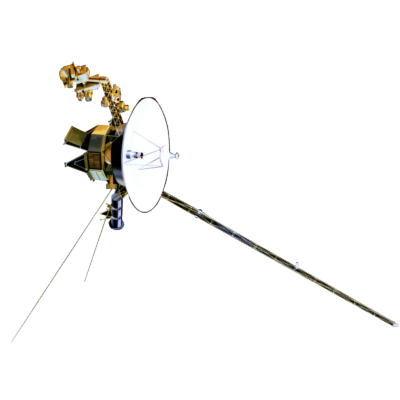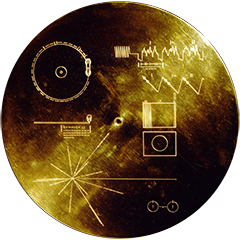Voyager LECP Data Analysis Handbook
Instrument Modeling Reports
by Sheela Shodhan
Chapter 2. Introduction to the Voyager Mission
The Voyager mission is a major element of NASA's strategy for the exploration of the outer solar system. Results from the Voyager Low Energy Charged Particle (LECP) instrument have been described elsewhere [3].
- To conduct exploratory investigations of the Jupiter and Saturn planetary systems with emphasis placed on the comparative studies of the two systems, including their environments, atmospheres and body characteristics [2].
- To conduct exploratory investigations of the interplanetary medium from Earth to Saturn [2].
- There was also an extended mission option for Voyager 2 to fly by Uranus and thus provide the first investigations of the planet and interplanetary studies beyond 20 AU (which we now know has been realized) [2].
Voyager 2 is scheduled to arrive at Neptune on 24 August 1989. The gravitational force of Neptune will veer the spacecraft sharply towards its moon Triton. The Voyager spacecraft will then continue into the outer reaches of the solar system to the heliopause and beyond.
The large complement of scientific instruments aboard each Voyager allows the investigation of particles and fields as well as the broad coverage of the electromagnetic spectrum [2].
| spacecraft |
launch date (1977) |
Jovian system (1979) |
Saturnian system |
Uranian system (1986) |
| Voyager 2 | 20 Aug. | 09 July | 26 Aug.* | 24 June |
| Voyager 1 | 05 Sept. | 05 March | 12 Nov.** |
Table 2.1. The launch dates and the dates of closest approach to the planetary systems. Note: * indicates 1981, ** 1980
2.2 The Low Energy Charged Particle Experiment (LECP)
2.2.1 Objectives of the experiment
- investigate the existence, spatial extent and dynamical morphology of the Saturnian and Uranian magnetospheres [3],
- investigate the quasi-steady energetic particle flux in interplanetary space [3],
- perform second generation studies of the composition, energy spectrum, azimuthal and pitch angle distribution of Jovian magnetosphere charged particles [3],
- study the energetic particle environments of natural planetary satellites [3],
- investigate large and small scale magnetic structures in the interplanetary medium and near planets using charged particle angular distributions [3].
2.2.2 Instrumentation
The above stated objectives are met by a single instrument which utilizes 23 solid state detectors configured in two distinct detector subsystems, each of which is optimized for a particular energy/intensity range and/or group of particle species. These are:
- Low Energy Particle Telescope (LEPT), optimized for interplanetary and interstellar measurements, and
- Low Energy Magnetospheric Particle Analyser (LEMPA), which is optimised for magnetospheric environments, i.e. for specific particle species, energies and intensities near the planets. Both subsystems, however, will contribute substantial measurements which are important to both environments.
It is important to determine the particle anisotropies and since the Voyager spacecraft has a fixed orientation, both the subsystems are mounted on a rotating platform that is stepped through eight 45 deg. sectors in periods ranging from 48 seconds to 48 minutes.
2.2.3 LEMPA
The detectors in the LEMPA subsystem are designed for:
- low energy thresholds (approx. 15 keV),
- clean separation of ions from electrons,
- good sensitivity,
- large dynamic range.
LEMPA uses two primary identification methods:
- Low and medium energy electrons are deflected into Beta and Gamma detectors via a sintered Cobalt-Samarium rare earth magnet while the more massive protons and ions pass through the magnet's field and strike the detector alpha.
- It employs a combination of shielding and energy loss to restrict the response of A and B to high energy particles.
2.2.4 BETA and GAMMA detectors
These are designed to measure the low and intermediate portions of the electromagnetic spectrum respectively, primarily to measure low energy ( ณ 15 keV) electrons. They are also designed to measure large fluxes in the Jovian magnetosphere and at the same time to be capable of measuring interplanetary electrons such as those emitted in solar particle events. Energy spectra available from these detectors during the planetary encounters will be crucial in examining in depth particle acceleration and loss processes associated with satellite interactions in the planetary magnetospheres.
The table showing the areas of the Beta and the Gamma detectors for Voyager 1 and Voyager 1 [1]:
| spacecraft | detector | area mm2 |
| Voyager 2 | Beta | 7.2 |
| Gamma | 6.2 | |
| Voyager 1 | Beta | 7.49 |
| Gamma | 6.38 |
Table 2.2. Areas of the Beta and the Gamma detectors for Voyager 1 and Voyager 2
The nominal LECP/LEMPA electron characteristics for Voyager 1 and Voyager 2 are [1]:
| channel | passband MeV/N |
geometric factors |
| Eβ1 | 0.0159-0.0370 | 0.00600 |
| Eβ2 | 0.0370-0.0610 | 0.00600 |
| Eβ3 | 0.0700-0.1120 | 0.00600 |
| Eβ4 | 0.1300-0.1830 | 0.00600 |
| Eβ5 | 0.2000-0.5000 | 0.00600 |
| Eγ6 | 0.2520-2.0000 | 0.00200 |
| Eγ7 | 0.4800-2.0000 | 0.00200 |
| Eγ8 | 0.8530-2.0000 | 0.00200 |
| Eγ9 | 2.1000-5.0000 | 0.00200 |
Table 2.3. Nominal LECP/LEMPA Electron Characteristics for Voyager 1
| channel | passband MeV/N |
geometric factors |
| Eβ1 | 0.0125-0.0350 | 0.00200 |
| Eβ2 | 0.0350-0.0610 | 0.00200 |
| Eβ3 | 0.0610-0.1120 | 0.00200 |
| Eβ4 | 0.1120-0.1830 | 0.00200 |
| Eβ5 | 0.1830-0.5000 | 0.00200 |
| Eγ6 | 0.2520-2.0000 | 0.00200 |
| Eγ7 | 0.4800-2.0000 | 0.00200 |
| Eγ8 | 0.8530-2.0000 | 0.00200 |
| Eγ9 | 2.1000-5.0000 | 0.00200 |
Table 2.4. Nominal LECP/LEMPA Electron Characteristics for Voyager 2
Figures:
- Figure 2.1. Voyager spacecraft and scientific instruments
- Figure 2.2. A picture of the first flight unit of the LECP experiment
Return to thesis table of contents.
Return to Voyager
LECP Data Analysis Handbook Table of Contents.
Return to Fundamental
Technologies Home Page.
Updated 8/9/19, Cameron Crane
VOYAGER 1 ELAPSED TIME
*Since official launch
September 5, 1977, 12:56:00:00 UTC
VOYAGER 2 ELAPSED TIME
*Since official launch
August 20, 1977, 14:29:00:00 UTC
QUICK FACTS
Mission Duration: 40+ years have elapsed for both Voyager 1 and Voyager 2 (both are ongoing).
Destination: Their original destinations were Saturn and Jupiter. Their current destination is interstellar space.



